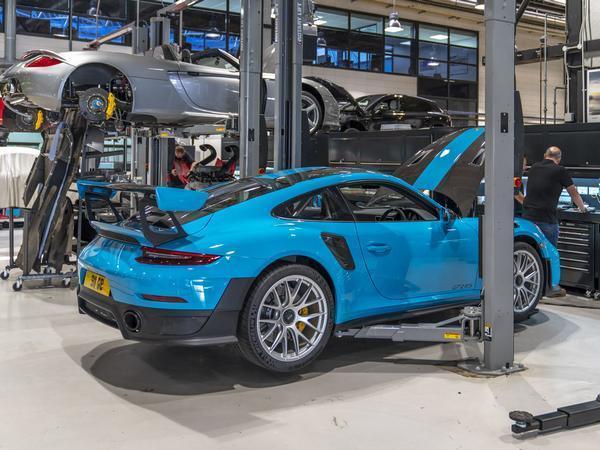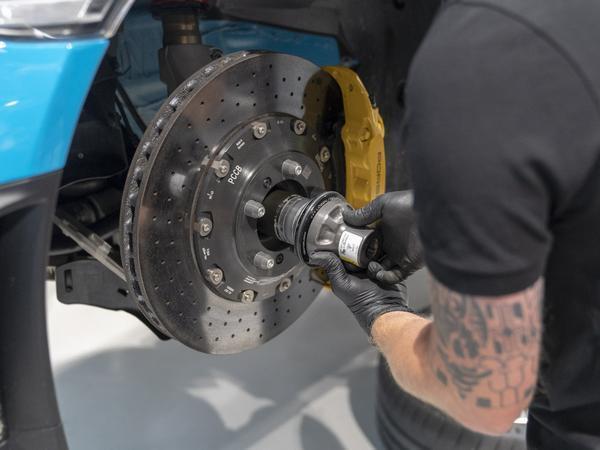Porsche UK Operations Workshop: PH Meets
What actually happens to a car when it returns from a press loan? Time to find out...

Four hundred and forty three pound feet of torque. That's how much force is required to remove the wheel of a Porsche 911 GT2 RS. I know, as I've just done exactly that, using the mother of all torque wrenches to do so. That wrench was tucked away in the 'special tools' room in Porsche's UK Group Operations Workshop, a room that's worthy of a feature itself. Porsche's Group Operations in Reading deals with the company's more specialist vehicles. If you've a Carrera GT, 918 Spyder or 959 it'll have been serviced here, several Carrera GTs and 918s currently present in various states of undress as they're being prepped for customers ready for summer outings.
VIP cars, track car preparation and the press cars are all dealt with at Group Operations, too, the Miami Blue 911 GT2 RS I'm working on having just come back from Scotland, where I drove it on a press event. Call it penance for that experience, or simply that I was curious to see what happens to a press car when it comes back from a loan, but I'm going through a post loan check up. Not alone, of course, being under the watchful, experienced eye of Richie Payne, Porsche's press fleet technician.
Payne is Porsche UK's unsung hero, as well as inspecting and working on all the press cars in Group Operations he's often sent to accompany them on the more unusual trips. More often than not that means changing shagged tyres after one too many smoky cornering shots, or driving cars for photography, its Payne's face you'll see in many a UK Porsche press driving shot. He's at his desk today, or more accurately his Dura workbench and lift, the GT2 RS raised preparation for its next loan. Preparation which I'll be doing.

Those brake cooling ducts on the bonnet cause the first issue. They need removing to get at the battery panel. In a regular GT2 RS they'll be off very occasionally, but 991 GB's are removed at least once a week. The battery is checked with a charger that's more NASA tech than anything you might have at home though we're under here to get at the 'thermos flask' alongside it. That 'flask' contains the attachment to remove the GT2 RS's centre lock wheels, as well as a handy little device for getting the RS centre caps off. That's the easy bit, the 443lb ft of force required to get them off is the proper grunt work. Nut loosened I've got to be mindful of the Optimol, an anti-seize heat-resistant paste which I'm told once is on you, is a nightmare to get off.
All the stuff I've written about lighter Weissach Pack cars is brought into focus when I go to remove the rear wheel. I'm braced for more weight, the expectation being that the 21-inch rim with its Michelin Cup 2 tyre would be heavier than it is. It's light, relatively speaking, of course, getting it off allowing a good inspection of the wheel and tyre as well as the brakes behind. Just the three more to go... Nothing significant to report, but we do spot a light groove inside one of the front wheels where a stone's scored it when caught between the calliper and the rim. Tight tolerances even with the 20-inch front rim, and I know exactly where it happened.
The Scotland trip saw the GT2 RS drive over a newly re-surfaced road, that horrendous type where they chuck the gravel down and leave it for a few days. The chattering of the gravel back then was disturbing, and now I'm finding it everywhere. The vents fore of the front wheels are full of it, requiring raking out with a pick tool, handfuls of the stuff going in the bin.

That's nothing, admits Payne, unsurprisingly he's seen cars come back with much bigger issues. Most of these he's not allowed to discuss, though he will admit to wondering how the hell one car came back with a flattened exhaust, until he saw the jump shot a few weeks later in the pages of a magazine.
Given the press cars are like the village bike, they're meticulously prepared and inspected, and today there's no hiding thanks to vehicle diagnostics. Plugging in allows us to check absolutely everything imaginable. We can tell things like if it's been driven with the bonnet open - it not unusual to have a photographer jump in the front of a 911 for a tight rear driving shot of a car it's following (test tracks only, of course). The diagnostics know if it's been driven with a seatbelt undone, the speeds, distances and any warnings, faults or tyre issues. Indeed, anything you can think of, will be flagged up on Payne's laptop. Nothing untoward today, thankfully, given I was one of the last people to drive it...
There's a good visual inspection while its up on the lift, it interesting to see not just the carbon fibre anti-roll bars the Weissach Pack brings, but the controls that operate the sports exhaust and the underbody aero. Everything's in order so it's good to go and we put the wheels back on, careful to tighten, loosen, then re-tighten those single nuts, then check and adjust the tyre pressures before lowering it. Fluids are all checked, washers topped up then it's a case of clearing the navigation, radio presets and telephone Bluetooth connections so the next recipient can set it up how they like it. A 10 mile road test follows, and a full valet, before it's ready to be delivered to the next jammy journo. If it comes back with nothing more untoward than a little bit of gravel to fish out of the grilles, Richie Payne would appreciate it...






Gassing Station | General Gassing | Top of Page | What's New | My Stuff



